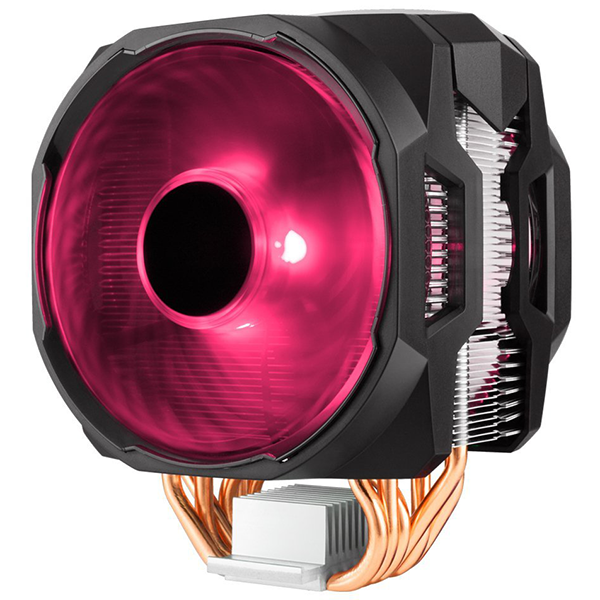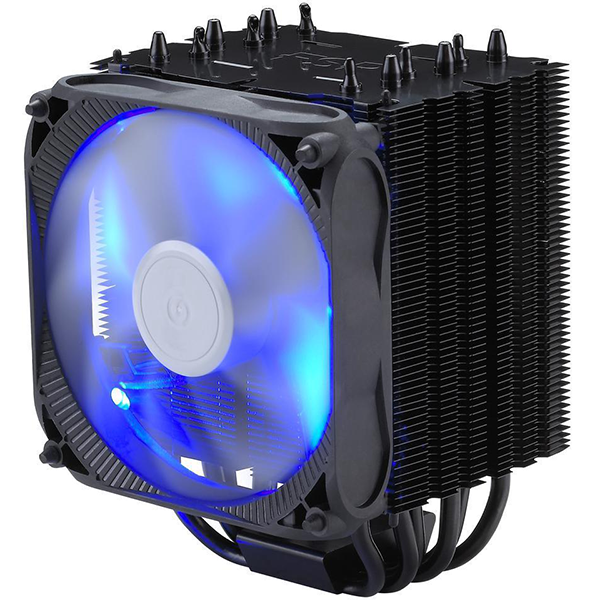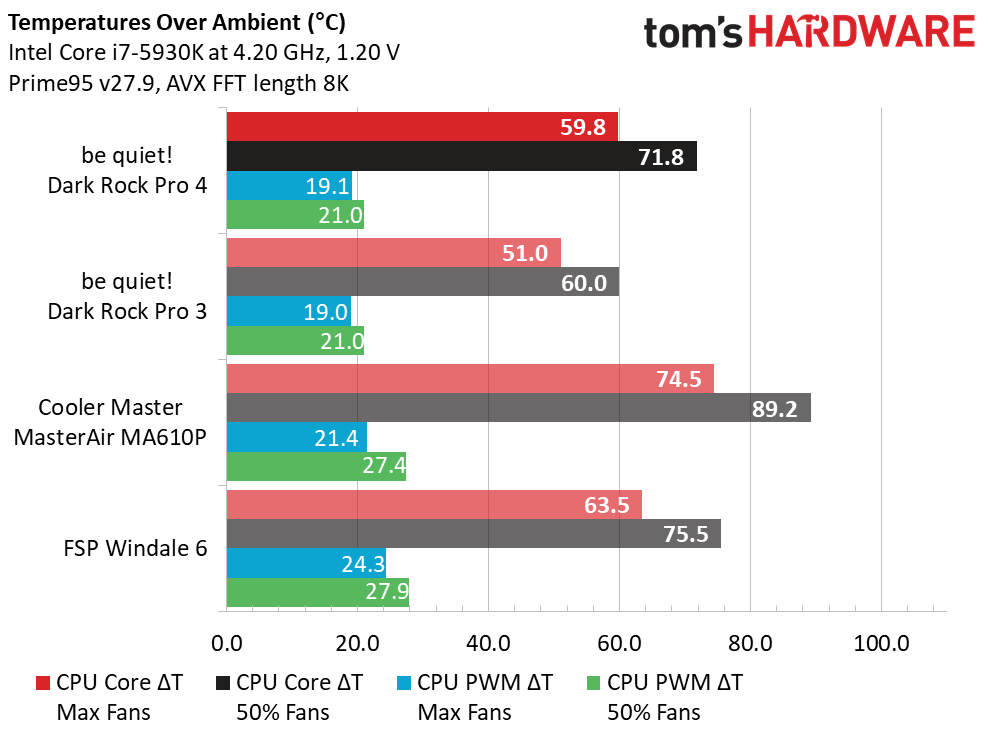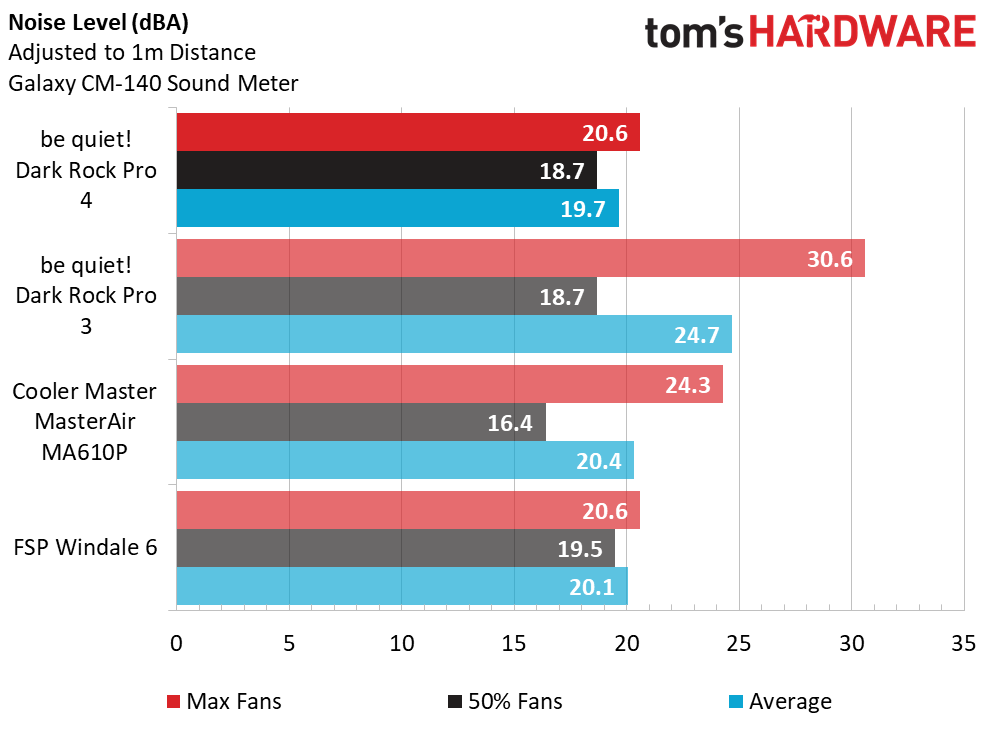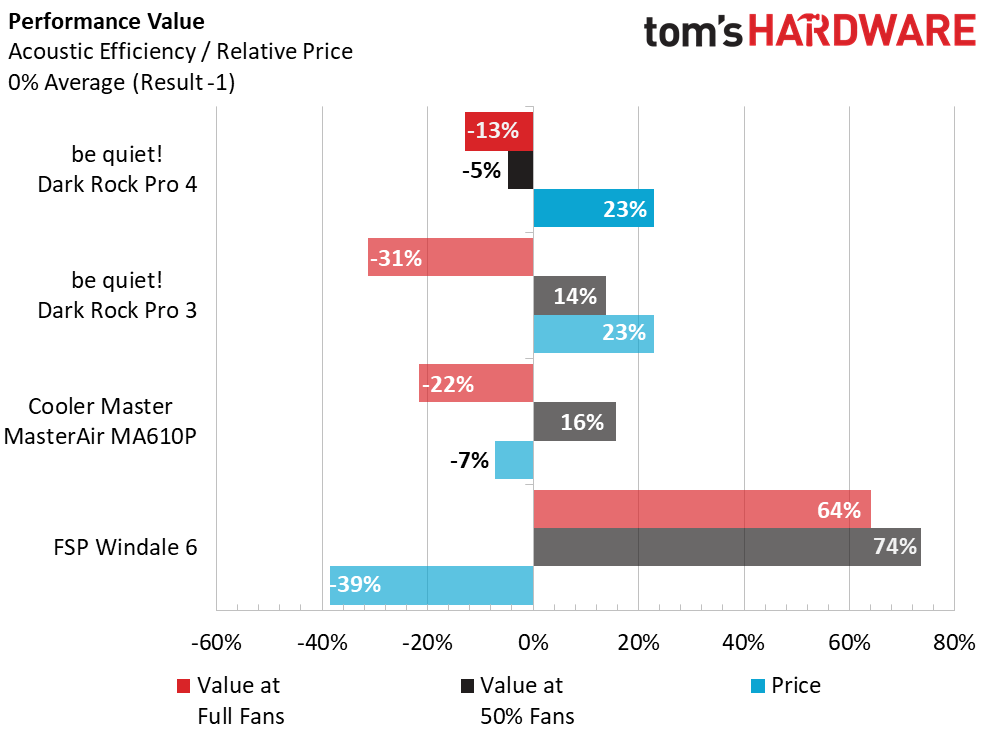be quiet! Dark Rock Pro 4: Return to the Dark Side
Why you can trust Tom's Hardware
Testing Results & Conclusion
Comparison Products
Our cooling comparisons are built upon data collected from standard testing methods in prior CPU-cooler reviews. We will be looking at the results from the be quiet! Dark Rock 4 Pro, along with the Dark Rock 3 Pro, the Cooler Master MasterAir MA610P, and the FSP Windale 6. All of these represent large tower coolers armed with six (or more) heatpipes. As usual, our Intel Core i7-5930K-based test system, overclocked to 4.2GHz with a vCore of 1.20V, provides six cores of thermal punishment.
The Dark Rock Pro 4 doesn’t seem to muster the same cooling potential as its predecessor, the Dark Rock Pro 3, although both be quiet! models outperform the Cooler Master MasterAir MA610P and the FSP Windale 6 in thermal load comparisons. However, the Dark Rock Pro 3 and Dark Rock Pro 4 share very similar designs. Can we even begin to deduce where the differences lie?
Above is a clue: Fan speeds may hold the answer?
Both of the be quiet! Dark Rock Pro coolers make use of dual fans, and while the Dark Rock Pro 4 primary fan at full speed spins approximately 100 RPM faster than the Pro 3 primary fan, the secondary fan for each cooler tells a tale of sharp contrast. The Dark Rock Pro 3 secondary tach reading reported 2080 RPM at 100%, while the Dark Rock Pro 4 secondary tachometer shows a reading just over 1500 RPM...more than 500 RPM difference.
In the course of giving up a few degrees of cooling potential, the Dark Rock Pro 4 makes up for it by being the quietest cooler of the group. Indeed, we measured near-inaudible noise readings. One benefit to large heatpipe-based air coolers like this one is the sheer mass and volume of cooling fins they possess to help radiate thermal energy away from the CPU.
With great performance and undeniably hush-hush sound levels, the Dark Rock Pro 4 keeps all the bars on the good side of the chart above. The FSP Windale 6 is the only other cooler to maintain three positive values, while the half-speed performance of the Dark Rock Pro 3 shows cooling prowess and pin-drop silence can be made to co-exist.
The overall "Performance Value" metric, graphed above, allows us to work a pricing angle into these comparisons. The $90-MSRP cost of the Dark Rock Pro 3 and Pro 4 models is a big blow here, a reversal of their prior charting victories. Meanwhile, the FSP Windale 6 (priced 50% less) turned in closer-to-average scores, and it gains big ground on the other coolers due to its budget pricing. But it arguably doesn’t have the imposingly cool design and feature set of the others in the group.
Get Tom's Hardware's best news and in-depth reviews, straight to your inbox.
The be quiet! Dark Rock Pro 4 impresses us, even though we did see a bit of a shake-up in cooling potential versus the prior (Dark Rock Pro 3) model. In turn, the newer model's noise levels are a positive trade-off. Also, consider that our punishing six-core test system pushes wattage loads greater than those of most overclocked quad-core CPUs. Most enthusiasts willing to pay good money for big air cooling can rest easy knowing that the performance they’re buying is still very much present in the newer Dark Rock Pro.
With the Dark Rock Pro 4's handsome design and impeccable build quality, be quiet! continues to impress with its stealthy flagship line of coolers. We would have liked to see cooling potential a bit closer to what we saw from the previous model. But with be quiet! using fans of dissimilar speeds, we’re happy to have the benefit of almost the same cooling ability, but at lower noise levels.
MORE: Best CPU Cooling
MORE: How To Choose A CPU Cooler
MORE: All Cooling Content

Garrett Carver is a contributor for Tom’s Hardware, primarily covering thermal compound comparisons and CPU cooling reviews; both air and liquid, including multiple variations of each.
-
AgentLozen The Dark Rock 4 is a solid cooler no doubt. I like how quiet it is compared to last generation Dark Rock 3. And no LEDs? /swoonReply
What's really interesting about this article is how it paints the Windale fan in such a favorable light. The numbers show that that cooler is competitive in most metrics with the Dark Rock 4 but costs half as much.
If the Dark Rock 4 got the coveted Editor's Choice award, then the Windale must have gotten something even better!! Let me read the review and see what high praises you guys gave it... oh, that's curious... -
dhasootitin1729 Why did not you add the results of the similarly priced Noctua NH-D15? After all the Dark Rock 4 resembles the NH-D15 the most, dimension wise.Reply -
SkyBill40 I'm glad to see this isn't a part of the RGB movement that's seemed to infect everything. This somewhat reminds me of my CM V6GT which I really like... for twice the price. :/Reply
I like air cooling over the complexities of a dedicated water cooling setup or even an AIO, but I don't like it for this price and seeing how I could get the same for cheaper in an alternative solution. Still, that aside, it's a highly capable unit that gets the job done albeit somewhat expensively. -
photonboy DHASOOTITIN1729,Reply
I'd recommend looking at the NH-D15S instead if looking for or recommending a Noctua high-end cooler... the newer NH-D15S is much more compatible with memory (clearance), the top PCIe slot, uses a single fan, less space, less weight and yet the cooling performance under heavy load is only about 1degC difference (i.e. 75degC vs 74degC). -
Olle P Covered RAM shouldn't be an issue if you mounted the cooler rotated 90 degrees, which is the only way it can be mounted on an AMD motherboard...Reply
That alone makes it a deal breaker for me!
(False! Corrected in a new post below.) -
10tacle For those wondering, Noctua didn't send Tom's Hardware team an NH-D15 to test. Guru3D has a comparison of it though here:Reply
http://www.guru3d.com/articles-pages/be-quiet-dark-rock-pro-4-review,1.html
With that said, I like the looks of it. On par performance with the NH-D15 and MUCH better looking for those who don't want to paint their Noctua cowling and fan(s) which can throw fan balance off shortening the life of the motor. According to Guru's test, it's also much quieter than the NH-D15 which at one time along with the older NH-D14 were very quiet themselves. And it's priced competitively too. -
envy14tpe Reply20876033 said:For those wondering, Noctua didn't send Tom's Hardware team an NH-D15 to test. Guru3D has a comparison of it though here:
http://www.guru3d.com/articles-pages/be-quiet-dark-rock-pro-4-review,1.html
With that said, I like the looks of it. On par performance with the NH-D15 and MUCH better looking for those who don't want to paint their Noctua cowling and fan(s) which can throw fan balance off shortening the life of the motor. According to Guru's test, it's also much quieter than the NH-D15 which at one time along with the older NH-D14 were very quiet themselves. And it's priced competitively too.
Don't need to be sent free samples to test a product.

